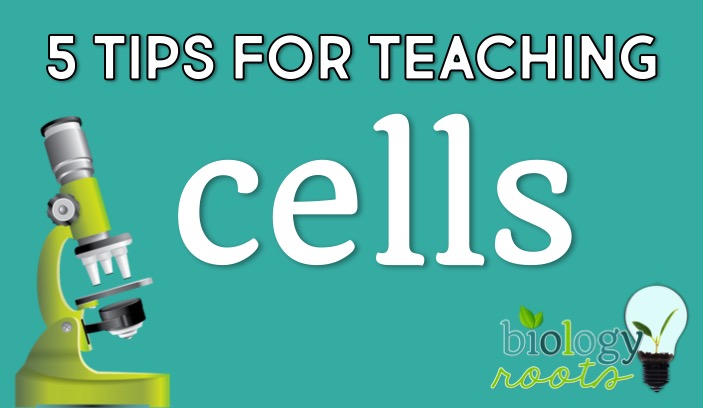Cells- they are the basic unit of function and structure of life and tie EVERYTHING into biology. As we delve into genetics, photosynthesis, cellular respiration, these are all processes that occur inside the cell. Evolution depends on genetics, which depends on DNA, which is found…. in the cell. Our nerve impulses depend on a voltage gradient required to deliver information which depends on… cells. Harvesting energy from the sun? Cells!
The whole reason we are able to live and survive comes down to cells. Yet students tend to forget all about them!
Here are 5 7 Helpful Tips for Teaching Cells:
Before we delve into the teaching part, I always found it helpful to establish with my biology students that everything in biology connects to cells– Give your students a heads up that everything in the course relates to the cell structure and vice versa. If you tell them that cells are the foundation of the class, they will be looking for this later and are more apt to make connections. I use my interactive cell model resource to help them with this throughout the year (link found below).
As you go to to teach other topics, highlight the parts of the cell that they’ve already covered and tie it into the lesson. Making these connections helps students remember.
1. Use simple terms at first– When describing organelles at the beginning of the year, use terms the students can understand. To just say that mitochondria is where cellular respiration occurs is not enough- even to say it’s where ATP is produced is not enough. These are meaningless definitions when learning about cells early in the year because your students most likely do not know what cellular respiration or ATP are. Instead, you could say that mitochondria is an organelle where energy is converted into a usable source- and later add via a process known as cellular respiration in which glucose is converted into a usable energy form called ATP. It’s to fill the gaps in later!
2. My-my-my-my-my-my-my-microscope (to be sung to the tune of Lady Gaga’s Poker Face). Use that microscope! Kids LOVE looking at their own cells. A simple cheek swab slide or a pond water specimen will get kids engaged -and can I get an amen for practicing those microscope skills?
However, if materials are limited- there are plenty of online resources such as this virtual microscope simulation.
3. Use interactive and 3D models- try to use models that are as visually accurate and stunning as possible when teaching cells. Cells Alive and Centre of the Cell are great places to start. I would also encourage you have students make their own mini models are do a collaborative classroom effort to make a cell model (cake, clay, or paper mache!)
4. Use Analogies- Because cell organelle functions are typically taught first, it can be overwhelming for students. Just as a city or a school has a lot of jobs that are contribute to the overall function and well-being, a cell has a lot of organelles with jobs that contribute to the life of the cell.
5. CASE STUDIES- students love case studies where they get to act like detectives to solve medical mysteries. And this gives them a higher understanding of the organelles and how they can affect the entire function of the cell (and organism). It’s a win-win!
6. OK, ok- I know I typically do 5 helpful tips but here’s another: Keep it real and use visuals! I love using these videos to show the amazing world of cells in an entertaining way:
Amoeba Sisters: Grand Cell Tour David Bolinksy: Visualizing the Wonder of a Living Cell An immune cell chasing a bacterium Plant Cells by Crash Course & Khan Academy
7. And lastly… allow opportunities for the students to connect. Numbers 5 and 6 above help with this, but it’s also useful to relate the cell organelles to the different types of cells in the body systems! This also establishes that not all cells are created equal, a cardiac muscle cell is very different than a white blood cell, for example!
Need more resources? Don’t reinvent the wheel.
The interactive cell model is designed to start off basic and change and grow as your students learn more with each unit. For example, you can start building a basic cell, then as your class learns more about the cell membrane, you can add the plasma membrane to your model. As the cell learns more about photosynthesis, you can exchange the chloroplast for a different and more specific diagram.
Need a way to introduce or reinforce cells to your class? Exhibition stations are a perfect way to make that happen. An example of what the stations might look like is pictured at right ->
Students would use these exhibition stations as a way to absorb the material at their own rate. They visit station to station where the information is chunked in an organized way and record the answers onto their student recording sheet, which looks something like this:
“Absolutely thrilled with this product! Perfect for my home schooled daughter. She learned so much in such a short amount of time. Looking forward to buying more of your creations as we move through the year. Thanks!” – Buyer
“I loved this activity and so did the students. Thanks for a well thought out activity. Great job.”- Nadine S.
Thanks for reading my tips! Questions? Please contact me.




